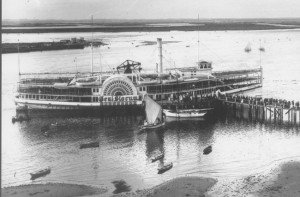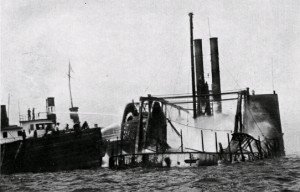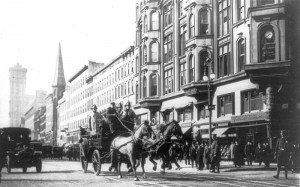There is a memorial in Tompkins Park in Manhattan Island, New York City, which is there as a reminder of what was, prior to September 11, 2001, the worst disaster in terms of loss of life in New York. The disaster was the burning of the General Slocum steamboat on the East River of New York City. The boat fire disaster occurred in the year 1904 and there are reasons why this event somehow was shadowed by other events which may have contributed to the fading of it’s memory.
There has been a lot written about steamboat safety in general, particularly during the mid 1800’s. Because steam power was the power of choice, it was employed extensively. Steamboats plied rivers all over the country including even in the far west. Knowledge of the technology of steam power was another matter.

Steamboat boiler explosions were happening much too often and in some cases with hundreds of fatalities. The most deadly steamboat boiler explosion recognized by many historians was the Sultana explosion in April 1865 just north of Memphis Tennessee on the Mississippi River. The Sultana was packed, even overly packed, with Union soldiers heading back to the north at the end of the American Civil War. In the book Sultana: Surviving the Civil War, Prison and the Worst Maritime Disaster in American History, author Alan Huffman describes how the steamboat operators were paid by head count thus encouraging them to grossly overload many vessels. The boat was so overloaded that it was difficult to even find room to lay down.
The sidewheel steamboat General Slocum, launched in 1891, was named after Henry Warner Slocum, a Civil War General of some fame who was also a congressman from the state of New York. The vessel was owned and operated by the Knickerbocker Steamship Company and generally worked carrying passengers around the New York City waterways. The boat was captained by William H. Van Schaik who was 68 years of age.
The Disaster
It so happened that the General Slocum was chartered by a Lutheran Church in New York, St. Marks Evangelical Lutheran Church, to take a group of St Marks New York church members on a picnic to Eatons Neck Long Island. The vessel was chartered for a cost of $350 for the date of June 15, 1904. Most of those who be making the trip were women and children. As the church band played while the General Slocum departed at 9:30 am everyone onboard was looking ahead for a fine ride and a day away from the big bustling city. Trouble started relatively soon on the voyage. About forty minutes after pulling away from the dock and heading north on the East River a fire erupted onboard the boat.

Afterwards, some would say the fire started in the Lamp Room and some others would point to a storage room. Some would also go on to say that the boat fire was caused, whether in either room, by a carelessly discarded cigarette. Many eyewitnesses even claimed the fire started in several different locations. Nevertheless, the blaze spread very rapidly.
Upon learning of the fire, Captain Schaik, with 1,358 passengers from St. Marks Church, headed for land at full steam. He was steering for Randalls Island but the blaze was engulfing the entire vessel aided by a strong breeze and the wind caused by the boat moving at full power. Heading at full steam to Randalls Island would later be a major criticism of Schaik’s handling of the emergency. It was suggested that he would have been wiser just heading to a nearby landing or just grounding the vessel. His speeding of the boat was felt to have added to the fires rapid spread. The vessel eventually beached at North brother Island.
The Aftermath
As with many large disasters and especially one that occurred around the beginning of the 20th century, statistics differ slightly. Officially, it was thought that 1,021 people were lost. The cause was either burning in the fire or drowning in the river. In the book, Ship Ablaze: The Tragedy of the Steamboat General Slocum, author Edward T. O’Donnell points out that there were not many among the church group who were experienced swimmers. The trip was to be a short hop and the fact that most people couldn’t swim didn’t seem to matter. Obviously, this was an enormous loss of life. For comparison, the much publicized Triangle Shirtwaist Building fire of 1911 in New York City claimed 146 mostly young immigrant women.
Investigations after the General Slocum burning turned up a host of safety violations. The violations were so serious that one might wonder why a vessel in this condition was carrying paid passengers in the first place. Among the safety violations were rotting fire hoses incapable of holding any water pressure, oily rags and straw on the floor of several rooms and inferior life preservers that some reports stated were manufactured incorrectly. Also, the boat fire extinguishers were inoperable. All of this combined to cause New York City’s second most deadly disaster.
The public outrage was predictable. A Federal Grand Jury indicted eight individuals. In addition to Captain Schaik, two safety inspectors and officers of the Knickerbocker Steamship Company were indicted.

The only one convicted was Captain Schaik of the charges of criminal negligence, failure to conduct fire drills and not maintaining workable fire extinguishers. Incredibly, the steamship company received rather modest fines regarding the altering of inspection reports. Schaik’s sentence was ten years at Sing Sing Prison but Schaik was paroled after just three and one-half years. Just as with the exploding boiler problems on steamboats, after the General Slocum disaster, the federal government passed many new regulations regarding passenger ship emergency equipment.
There are several opinions why a disaster of this magnitude did not really receive it’s deserved place in history. The sheer number of fatalities in a single tragedy guaranteed worldwide shock. The question that remains is why was the Triangle Shirtwaist fire in 1911, with many less deaths, perceived as the worst disaster in New York at the beginning of the 20th century? By the 1920s the Triangle disaster stayed more strongly in the public consciousness. What was remembered of the General Slocum fire was a small, annual commemoration at the Lutheran cemetery in Queens. One theory is that the Slocum fire involved German immigrants. There was quite a bit of German hostility leading up to, through and after World War One causing the public legacy of the tragedy to fade from memory. There was simply less sympathy for Germans as opposed to the young immigrants killed in the Triangle Fire. Also, with the Triangle Fire it came to be found that the factory owners had purposely locked the exits as a matter of policy to keep the workers at their sewing machines. While many of the General Slocum Fire deaths resulted from the failure to maintain safety devices like boat fire extinguishers and life jackets, there wasn’t perceived criminal action by the owners which could still certainly be debated.
Two additional stories we have on Trips Into History which you will find interesting are the Explosion of the Steamboat Pennsylvania and the Storms of Lake Michigan and the sinking of the lake freighter Carl D. Bradley.
The General Slocum Fire spelled the beginning of the end for the closely knit “Little Germany” section of Manhattan’s lower east side. St Marks New York eventually was sold and became a synagogue. While the disaster claimed only about one percent of the city’s German population, the continual immigration of people from other European countries, mainly eastern Europe, splintered the population more and Little Germany residents scattered to other New York City locales.
(All photos are from the public domain)

I’m really enjoying the design and layout of your blog. It’s
a very easy on the eyes which makes it much more pleasant for me to come here and visit more often.
Did you hire out a designer to create your
theme? Outstanding work!